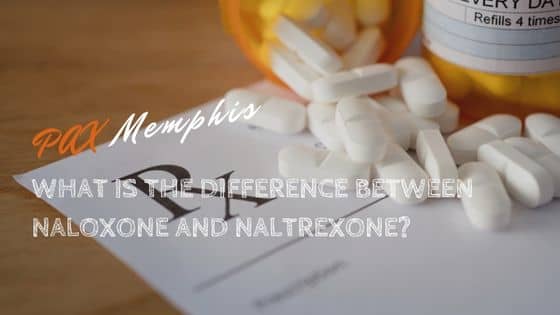Opioid use disorder (OUD) affects more than 16 million people worldwide and is a leading contributor to the astounding number of opioid overdose deaths the United States sees each day.[1] In an effort to reduce the impacts of opioid addiction, researchers have developed and the U.S. Food and Drug Administration (FDA) has approved several medications to help treat opioid use disorder and save lives. Two of these medications are naloxone and naltrexone.
Naloxone and naltrexone are often confused with one another. The names sound similar, and both drugs are opioid antagonists that help treat people suffering from opioid addiction. However, there are many notable differences between naloxone and naltrexone, including how they are used.
What is Naloxone?
Naloxone is an opioid antagonist that is used to temporarily reverse the effects of opioid overdose. A popular, widely-known brand name for naloxone is Narcan. There are two forms of naloxone: an injectable form (Evzio) and a nasal spray (Narcan). [2]
Naloxone is often carried by first responders and is used in emergency medicine, but anyone can purchase the nasal spray formulation of naloxone at a pharmacy and administer it in the event of an opioid overdose.[3]
Naloxone is a fast-acting drug that knocks opioid molecules off of opioid receptors in the brain, thereby reducing the effects of opioids. In doing so, the medication can temporarily restore breathing and consciousness to someone who has overdosed until medical help arrives.
Naloxone is also found in Suboxone, a combination medication containing buprenorphine and naloxone. Suboxone is approved to treat opioid use disorder. Naloxone is in the medication because it serves as a protective agent against opioid abuse by blocking the effects of opioid drugs.[4]
Naloxone Side Effects
It is common to experience side effects after being given naloxone for an overdose. The side effects are typically related to acute opioid withdrawal and may include:
- Body aches
- Irritability
- Agitation
- Runny nose
- Diarrhea
- Vomiting
- Loss of appetite
What is Naltrexone?
Naltrexone is a prescription medication that comes in the form of a pill or an extended-release intramuscular injection. It is approved for the treatment of opioid use disorder and alcohol use disorder.[5,6]
The first form, the pill, is sold under the brand names ReVia and Depade. The pill is taken on a daily basis. The second form, the intramuscular injection, is known as Vivitrol. Vivitrol is administered by a healthcare professional once monthly.
Like naloxone, naltrexone is an opioid antagonist, so it blocks opioids from binding to opioid receptors, preventing people from being able to get high on opioids. Naltrexone has been proven to reduce the intensity of drug cravings as well as the risk of relapse. Unlike many of the other opioid use disorder treatment medications, including Suboxone, naltrexone does not have a risk of abuse or addiction. Because it is so effective and non-habit-forming, it is one of the most commonly used medications to treat addictions to alcohol and opioids.
Patients must wait 7-14 days after their last dose of opioids before starting naltrexone. Starting the medication too early can result in unpleasant side effects.
Naltrexone may cause side effects, including:
- Injection site pain
- Headache
- Nausea
- Diarrhea
- Loss of appetite
- Muscle or joint pain
- Constipation
- Irritability
- Dizziness
- Toothache
- Cold symptoms
- Abdominal pain
Understanding Opioid Antagonists
Opioids work by binding to opioid receptors in the brain. Opioid receptors are responsible for controlling pain sensations as well as addictive behaviors. Opioid antagonists work by blocking opioids from binding to opioid receptors, stopping the drug from causing euphoria or a “high.”[7]
Although both naloxone and naltrexone are classified as opioid antagonists, they have slightly different effects. Naloxone is a fast-acting medication that only lasts 30-90 minutes. It knocks opioids off of opioid receptors all at once in order to restore breathing to someone who has overdosed. However, naltrexone is a slow-acting medication that lasts one day in pill form and one month in injectable form. It has been shown to reduce drug cravings and be useful in treating opioid and alcohol use disorders.
Key Similarities and Differences Between Naloxone and Naltrexone
Similarities
The main similarity between naloxone is naltrexone is that they are both the same type of drug–opioid antagonists, and they are used to help people struggling with opioid addiction. Neither drug is habit-forming.
Differences
There are many key differences between naloxone and naltrexone, including:
- Naloxone is only used to treat opioid overdose; naltrexone is used to treat opioid and alcohol use disorders.
- Naloxone comes in the form of an injection or a nasal spray; naltrexone comes in the form of a daily pill or monthly injection.
- Naloxone is used in emergency medicine; naltrexone is used in inpatient and outpatient opioid treatment clinics as well as in primary care.
- Naloxone, in nasal spray form, is available over the counter; naltrexone is available via prescription only.
Find Help for Opioid Abuse and Addiction Today
There are many effective solutions available for opioid use disorder treatment–the hardest part is asking for help. If you or a loved one are struggling with opioid addiction, please contact our qualified admissions team today to learn about your treatment options. Call now to get started.
References:
- https://www.ncbi.nlm.nih.gov/books/NBK553166/
- https://www.fda.gov/drugs/postmarket-drug-safety-information-patients-and-providers/information-about-naloxone
- https://www.fda.gov/news-events/fda-voices/fda-issues-new-guidance-help-facilitate-availability-naloxone-prevent-opioid-overdoses-and-reduce
- https://www.ncbi.nlm.nih.gov/pmc/articles/PMC5855417/
- https://www.accessdata.fda.gov/drugsatfda_docs/label/2013/018932s017lbl.pdf
- https://www.accessdata.fda.gov/drugsatfda_docs/label/2010/021897s015lbl.pdf
- https://www.ncbi.nlm.nih.gov/books/NBK537079/
Medically Reviewed: September 25, 2019

All of the information on this page has been reviewed and verified by a certified addiction professional.










